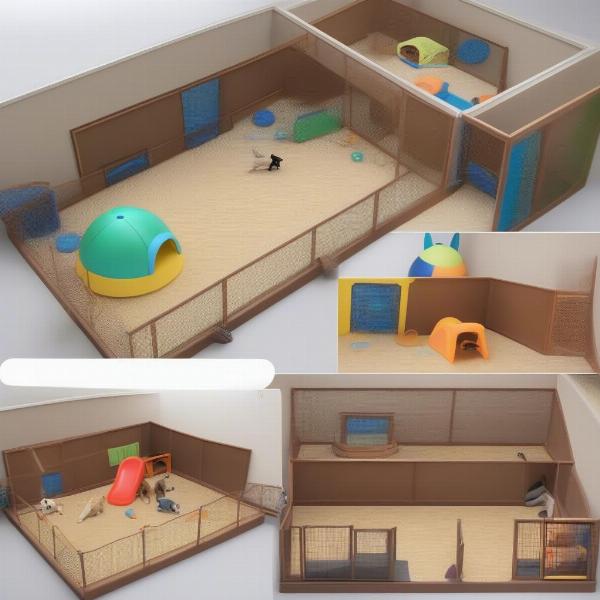Indoor dog play areas offer a safe and stimulating environment for your furry friend, especially during inclement weather or when outdoor space is limited. Whether you have a puppy bursting with energy or a senior dog needing gentle exercise, a dedicated indoor play space can significantly enhance their quality of life. This guide explores how to create an enriching and engaging dog play area within the comfort of your home.
 Indoor Dog Play Area Ideas
Indoor Dog Play Area Ideas
Choosing the Right Location for Your Dog’s Indoor Play Area
Selecting the right spot is crucial for a successful indoor dog play area. Consider a space that is easily accessible, well-ventilated, and away from high-traffic areas. A spare room, a finished basement, or even a designated corner in your living room can be transformed into a dog’s paradise. Ensure the chosen area is free of potential hazards like electrical cords, toxic cleaning supplies, and small objects your dog could swallow. The area should also be easy to clean, as accidents are bound to happen, especially with puppies.
Essential Elements for an Engaging Indoor Dog Play Area
A stimulating indoor play area should cater to your dog’s physical and mental needs. Incorporate a variety of toys to keep them entertained, including chew toys, puzzle toys, and interactive games. A comfortable dog bed or mat provides a cozy retreat for when playtime is over. small dog outerwear might be needed if the area is drafty. For dogs that enjoy digging, consider a designated digging box filled with non-toxic sand or shredded paper. If space allows, a small indoor agility course can provide a fun and challenging physical outlet.
Safety Considerations for Your Indoor Dog Play Area
Safety should be paramount when setting up an indoor dog play area. Ensure all toys are durable and non-toxic. Avoid toys with small parts that could be ingested. Regularly inspect the area for any potential hazards, such as loose wires or damaged furniture. If using a playpen, ensure it is sturdy and appropriately sized for your dog. Supervise your dog during playtime, especially if they are prone to destructive chewing or have a history of ingesting non-food items.
What about flooring?
Choosing the right flooring for your indoor dog play area is important for safety and comfort. Avoid slippery surfaces like tile or hardwood, as they can cause injuries. Rubber flooring, carpet tiles, or interlocking foam mats are excellent options as they provide good traction and cushioning. These materials are also easy to clean and maintain.
Enrichment Activities for Indoor Play
Keeping your dog mentally engaged is just as important as physical exercise. Incorporate puzzle toys, interactive games, and training sessions into their indoor playtime. Hide treats around the play area to encourage sniffing and searching. Teach new tricks or practice existing commands. Rotating toys regularly can help prevent boredom and maintain your dog’s interest. dog feeder outdoor can also be brought indoors for feeding sessions in the play area.
Maintaining a Clean and Hygienic Play Area
Regular cleaning is essential to maintain a healthy and hygienic indoor play area. Clean up any accidents immediately to prevent staining and odor. Wash bedding and soft toys regularly. Disinfect the flooring and any hard surfaces to eliminate germs and bacteria. Ensure proper ventilation to prevent the buildup of moisture and unpleasant smells.
Conclusion
Creating an indoor dog play area is a rewarding investment for both you and your furry companion. By providing a safe, stimulating, and enriching environment, you can enhance your dog’s physical and mental well-being, strengthen your bond, and ensure they thrive regardless of the weather or available outdoor space. Remember to prioritize safety, choose appropriate toys and flooring, and incorporate a variety of enrichment activities to keep your dog happy and engaged. big dog coffee shop can be a great place to meet other dog owners and share ideas about indoor play areas.
FAQ
- How much space do I need for an indoor dog play area? The size of the play area will depend on the size and activity level of your dog. Even a small designated corner can be sufficient for smaller breeds or less active dogs.
- What kind of toys are best for indoor play? Choose durable, non-toxic toys that cater to your dog’s individual preferences. Chew toys, puzzle toys, and interactive games are all great options.
- How often should I clean my dog’s indoor play area? Clean up accidents immediately and disinfect the area regularly, especially if your dog is prone to chewing or has accidents. Wash bedding and soft toys weekly.
- Can I leave my dog unsupervised in their indoor play area? Supervise your dog, especially during initial use, to ensure they are safe and not engaging in destructive behaviors.
- What type of flooring is best for an indoor dog play area? Non-slippery, easy-to-clean options like rubber flooring, carpet tiles, or interlocking foam mats are ideal.
- How can I keep my dog entertained in their indoor play area? Rotate toys, hide treats, and incorporate interactive games and training sessions to keep your dog mentally stimulated.
- What if my dog doesn’t seem interested in their indoor play area? Try introducing new toys, changing the layout of the area, or incorporating more interactive activities. dog statue peeing can be a fun decorative element to add personality to the space.
ILM Dog is a leading online resource dedicated to providing expert advice and guidance on all aspects of dog care and well-being. From breed selection and puppy care to senior dog health and training tips, we offer a wealth of information to help you provide the best possible care for your canine companion. We also offer expert advice on nutrition, grooming, and product recommendations. Contact us at [email protected] or +44 20-3965-8624 for personalized assistance. Visit ILM Dog for more information.